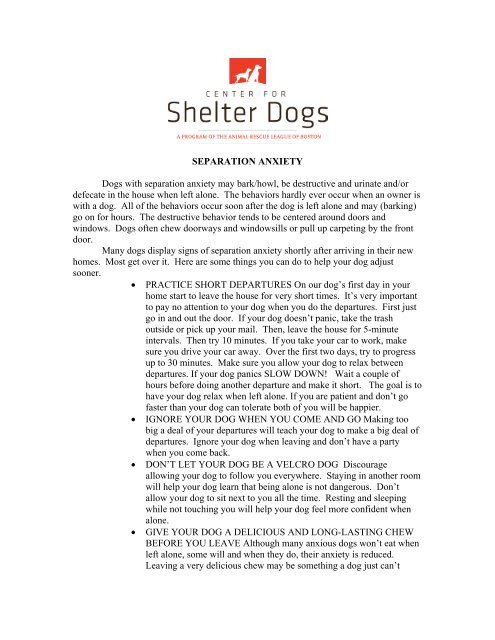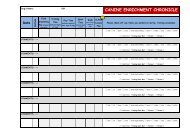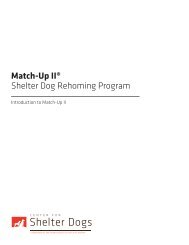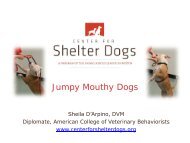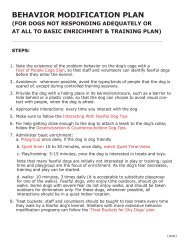Separation Anxiety - Center for Shelter Dogs
Separation Anxiety - Center for Shelter Dogs
Separation Anxiety - Center for Shelter Dogs
Create successful ePaper yourself
Turn your PDF publications into a flip-book with our unique Google optimized e-Paper software.
SEPARATION ANXIETY<br />
<strong>Dogs</strong> with separation anxiety may bark/howl, be destructive and urinate and/or<br />
defecate in the house when left alone. The behaviors hardly ever occur when an owner is<br />
with a dog. All of the behaviors occur soon after the dog is left alone and may (barking)<br />
go on <strong>for</strong> hours. The destructive behavior tends to be centered around doors and<br />
windows. <strong>Dogs</strong> often chew doorways and windowsills or pull up carpeting by the front<br />
door.<br />
Many dogs display signs of separation anxiety shortly after arriving in their new<br />
homes. Most get over it. Here are some things you can do to help your dog adjust<br />
sooner.<br />
PRACTICE SHORT DEPARTURES On our dog’s first day in your<br />
home start to leave the house <strong>for</strong> very short times. It’s very important<br />
to pay no attention to your dog when you do the departures. First just<br />
go in and out the door. If your dog doesn’t panic, take the trash<br />
outside or pick up your mail. Then, leave the house <strong>for</strong> 5-minute<br />
intervals. Then try 10 minutes. If you take your car to work, make<br />
sure you drive your car away. Over the first two days, try to progress<br />
up to 30 minutes. Make sure you allow your dog to relax between<br />
departures. If your dog panics SLOW DOWN! Wait a couple of<br />
hours be<strong>for</strong>e doing another departure and make it short. The goal is to<br />
have your dog relax when left alone. If you are patient and don’t go<br />
faster than your dog can tolerate both of you will be happier.<br />
IGNORE YOUR DOG WHEN YOU COME AND GO Making too<br />
big a deal of your departures will teach your dog to make a big deal of<br />
departures. Ignore your dog when leaving and don’t have a party<br />
when you come back.<br />
DON’T LET YOUR DOG BE A VELCRO DOG Discourage<br />
allowing your dog to follow you everywhere. Staying in another room<br />
will help your dog learn that being alone is not dangerous. Don’t<br />
allow your dog to sit next to you all the time. Resting and sleeping<br />
while not touching you will help your dog feel more confident when<br />
alone.<br />
GIVE YOUR DOG A DELICIOUS AND LONG-LASTING CHEW<br />
BEFORE YOU LEAVE Although many anxious dogs won’t eat when<br />
left alone, some will and when they do, their anxiety is reduced.<br />
Leaving a very delicious chew may be something a dog just can’t
efuse! Try a Kong toy or hollow marrowbone filled with either<br />
cheese spread or peanut butter and treats. Only give this toy be<strong>for</strong>e<br />
you leave. Pick it up when you come home.<br />
NOTHING IN LIFE IS FREE This is a program to teach your dog to<br />
politely ask <strong>for</strong> things be<strong>for</strong>e they are given. This is an easy way to<br />
become your dog’s gentle leader and to decrease your dog’s “Velcro”<br />
tendencies. All you do is to ask your dog to sit be<strong>for</strong>e you do anything<br />
<strong>for</strong> your dog. For instance: sit be<strong>for</strong>e being pet, sit be<strong>for</strong>e being<br />
greeted, sit be<strong>for</strong>e putting a leash on, sit be<strong>for</strong>e opening the door, sit<br />
be<strong>for</strong>e putting the food bowl down, sit be<strong>for</strong>e giving a treat, sit be<strong>for</strong>e<br />
throwing a ball, sit be<strong>for</strong>e getting in the car. Feel free to add things if<br />
you’d like.<br />
If your dog had separation anxiety in the previous home we may have taught your<br />
dog to be com<strong>for</strong>table resting and sleeping in a crate. As crating often increases<br />
anxiety, it’s important that you GRADUALLY get your dog used to being crated<br />
when left alone. Here are things you can try to get your dog see the crate as a safe<br />
haven rather than a scary jail cell.<br />
<br />
<br />
<br />
<br />
<br />
<br />
Place the crate in a part of your house that you spend a lot of time<br />
(bedroom, kitchen)<br />
Work first with the crate door open. When your dog is com<strong>for</strong>table<br />
entering, eating and resting in the crate with the door open, then close the<br />
door.<br />
Feed your dog meals in the crate. Allow your dog to enter the crate<br />
willfully. NO FORCE!<br />
Throw toys and treats into the crate <strong>for</strong> your dog to chase.<br />
Give your dog delicious long-lasting chews when crating. A Kong or<br />
hollow marrow bone filled with cheese spread or peanut butter and treats<br />
is perfect.<br />
When your dog is com<strong>for</strong>table in the crate with the door closed, walk out<br />
of the room and then back in.<br />
Leave the room <strong>for</strong> 5 seconds, 10 seconds, 20 seconds, 30 seconds, 45<br />
seconds, 1 minute, 2 minutes, 3 minutes, 4 minutes, 5 minutes. (See last<br />
bullet).<br />
Leave the house <strong>for</strong> 1 second, 3 seconds, 5 seconds, 10 seconds, 20<br />
seconds, 30 seconds, 45 seconds, 1 minute, 2 minutes, 3 minutes, 4<br />
minutes, 5 minutes, 10 minutes, 15 minutes, 20 minutes, 30 minutes.<br />
(See last bullet)<br />
<br />
When doing departures, ignore your dog’s complaints. If they don’t stop,<br />
go back to shorter departures. Do not let your dog out of the crate until<br />
there is little or no complaining


